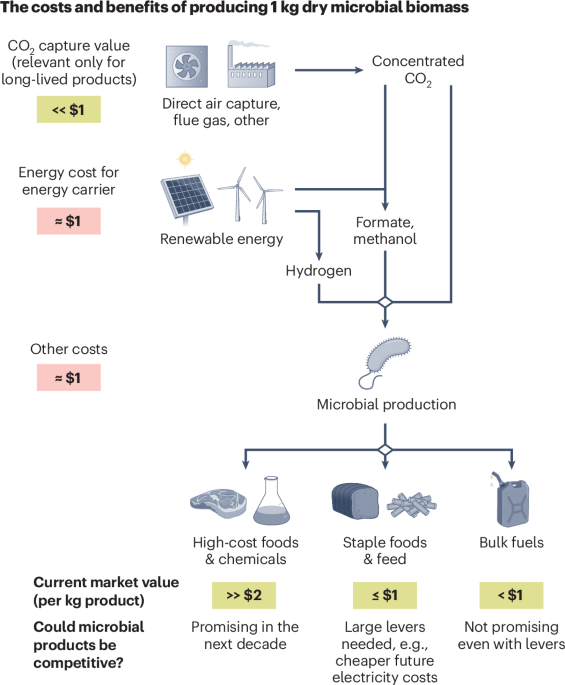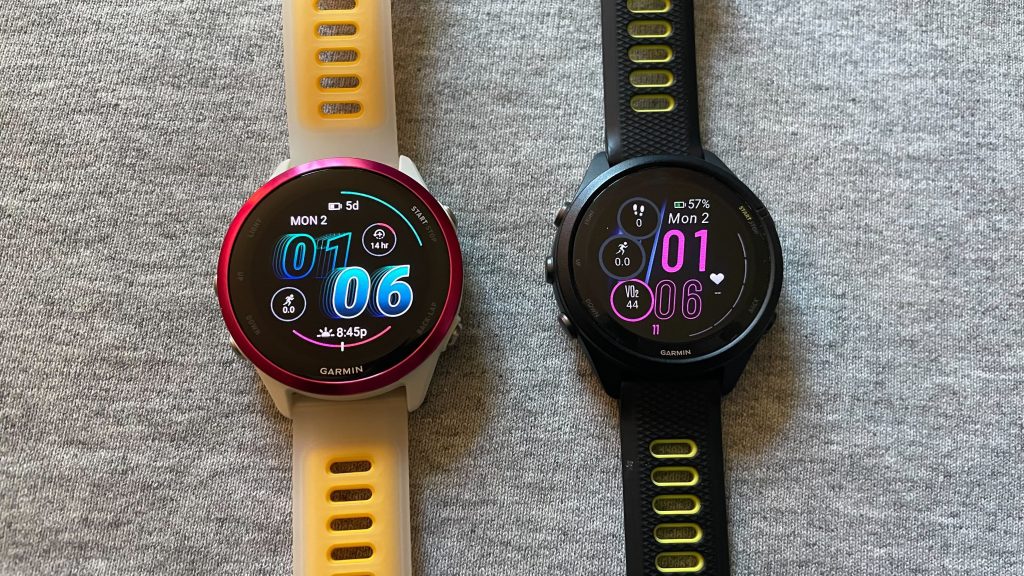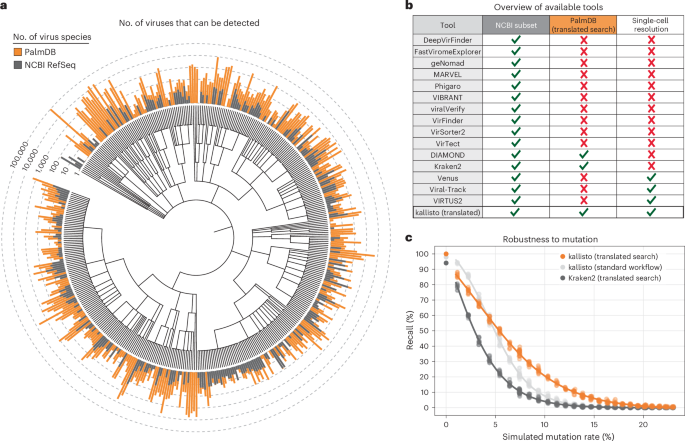- Comment
- Published:
(2025)Cite this article
Subjects
Producing goods, such as foods and fuels, with minimal environmental impacts is urgently needed. Although advances in bioproduction are promising, there is often a noticeable gap in our understanding of whether and where new processes can compete with existing methods on an economic and environmental basis. Transparent lower bound calculations from basic principles highlight potential benefits of producing foods, but not fuels, from electro-microbial production of biomass.
This is a preview of subscription content, access via your institution
Access options
Access Nature and 54 other Nature Portfolio journals
Get Nature+, our best-value online-access subscription
24,99 € / 30 days
cancel any time
Subscribe to this journal
Receive 12 print issues and online access
195,33 € per year
only 16,28 € per issue
Buy this article
- Purchase on SpringerLink
- Instant access to full article PDF
Prices may be subject to local taxes which are calculated during checkout
Data availability
The data used here are summarized in Supplementary Table 2 and can be found in the GitLab repository provided with this manuscript (https://gitlab.com/milo-lab-public/microbial-production-tea.git), together with details of data processing.
Code availability
The code used for the analysis has been deposited into GitLab (https://gitlab.com/milo-lab-public/microbial-production-tea.git).
References
-
Järviö, N., Maljanen, N.-L., Kobayashi, Y., Ryynänen, T. & Tuomisto, H. L. Sci. Total Environ. 776, 145764 (2021).
-
Graham, A. E. & Ledesma-Amaro, R. Nat. Commun. 14, 2231 (2023).
-
Keasling, J. et al. Nat. Rev. Microbiol. 19, 701–715 (2021).
-
Al Rowaihi, I. S. et al. PLoS One 13, e0196079 (2018).
-
Pham, J. V. et al. Front. Microbiol. 10, 1404 (2019).
-
Poore, J. & Nemecek, T. Science 360, 987–992 (2018).
-
International Energy Agency. From taking stock to taking action: how to implement the COP28 energy goals. https://www.iea.org/reports/from-taking-stock-to-taking-action (2024).
-
Claassens, N. J., Cotton, C. A. R., Kopljar, D. & Bar-Even, A. Nat. Catal. 2, 437–447 (2019).
-
Leger, D. et al. Proc. Natl. Acad. Sci. USA 118, e2015025118 (2021).
-
Way, R., Ives, M. C., Mealy, P. & Farmer, J. D. Joule 6, 2057–2082 (2022).
-
García Martínez, J. B. et al. Sustain. Prod. Consum. 25, 234–247 (2021).
-
World Integrated Trade Solution. Inactive yeasts; other single-cell micro-organi exports by country in 2023. https://wits.worldbank.org/trade/comtrade/en/country/ALL/year/2021/tradeflow/Exports/partner/WLD/product/210220 (World Bank, accessed 12 August 2024).
-
World Bank. World Bank commodity price data (the Pink Sheet). https://www.worldbank.org/en/research/commodity-markets (accessed 21 January 2025).
-
Fagerbakke, K. M., Heldal, M. & Norland, S. Aquat. Microb. Ecol. 10, 15–27 (1996).
-
Amadei, A. M., De Laurentiis, V. & Sala, S. J. Clean. Prod. 329, 129668 (2021).
-
Nappa, M. et al. ACS Omega 5, 33242–33252 (2020).
-
Finnigan, T., Needham, L. & Abbott, C. in Sustainable Protein Sources (eds. Nadathur, S. R., Wanasundara, J. P. D. & Scanlin, L.) 305–325 (Academic, 2017); https://doi.org/10.1016/B978-0-12-802778-3.00019-6
-
Biddy, M. J., Scarlata, C. & Kinchin, C. Chemicals from biomass: a market assessment of bioproducts with near-term potential. https://doi.org/10.2172/1244312 (National Renewable Energy Laboratory, 2016).
-
Gautam, M. et al. Repurposing agricultural policies and support: options to transform agriculture and food systems to better serve the health of people, economies, and the planet. http://hdl.handle.net/10986/36875 (World Bank Group, 2022).
-
Alexander, P. et al. Agric. Syst. 153, 190–200 (2017).
-
Food and Agriculture Organization of the United Nations. Gross domestic product and agriculture value added 2012–2021: global and regional trends. https://doi.org/10.4060/cc5253en (2023).
-
United Nations Economic Commission for Europe. Carbon Neutrality in the UNECE Region: Integrated Life-cycle Assessment of Electricity Sources (United Nations, 2022); https://doi.org/10.18356/9789210014854
-
Hertwich, E. G. et al. Proc. Natl. Acad. Sci. USA 112, 6277–6282 (2015).
-
Jin, Y., Behrens, P., Tukker, A. & Scherer, L. Renew. Sustain. Energy Rev. 115, 109391 (2019).
-
Hiete, M., Berner, U. & Richter, O. Glob. Biogeochem. Cycles 15, 169–181 (2001).
Acknowledgements
We would like to thank Lior Greenspoon, Gidon Eshel, Tamar Makov, Silvio Matassa, Charlie Cotton, Jan Lukas Krüsemann, Niklas Stolz, Yuval Rosenberg, William Newell, Milena Ivanisevic and the many other people we spoke with for their invaluable insights and support on this manuscript. This research was supported by the Tom and Mary Beck Center for Renewable Energy as part of the Institute for Environmental Sustainability (IES) at the Weizmann Institute of Science. R.M. holds the Charles and Louise Gartner Professorial Chair.
Ethics declarations
Competing interests
R.B.-N., E.N. and R.M are inventors on patent applications related to microbial production. D.L. is the co-founder of Cx Bio. The other authors declare no competing interests.
Supplementary information
Rights and permissions
About this article
Cite this article
Lovat, S.J., Ben-Nissan, R., Milshtein, E. et al. Electro-microbial production techno-economic viability and environmental implications.
Nat Biotechnol (2025). https://doi.org/10.1038/s41587-025-02632-w
-
Published:
-
DOI: https://doi.org/10.1038/s41587-025-02632-w
























